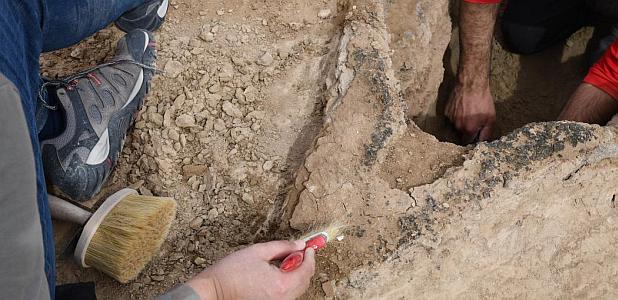
Photo: Deutsches Archäologisches Institut
When the burial ship at Sutton Hoo in the UK was uncovered in 1939, the ship itself was missing. The wooden planks and frames of the ship, dating from around 600 AD, had rotted away. Nevertheless, an almost intact impression of the hull was left in the hard-packed soil.
Now the remains of a Mesopotamian boat, estimated to date back 4,000 years, have been discovered. Like the Sutton Hoo ship, the organic material that made up the boat’s hull had rotted away, but the boat’s form was preserved by the waterproof coating of bitumen that had originally covered the hull.
The largely intact 4,000-year-old Mesopotamian boat was discovered in excavations of the ancient Sumerian city of Uruk by a joint German-Iraqi team. The Deutsches Archäologisches Institut describes the boat as 23′ long and up to 4.5′ wide. It is not thicker than 3/8″ in many places. The organic remains are no longer preserved and are only visible as imprints in the bitumen. During the excavation, the boat was documented three-dimensionally by photogrammetry. The archaeological context shows that it sank at the bank of a river that has since silted up, probably about 4000 years ago, and was overlaid by sediments.


 With the advent of Putin’s brutal invasion of Ukraine, we have posted about
With the advent of Putin’s brutal invasion of Ukraine, we have posted about  My wife and I took an incredible trip to the Galapagos in 2017. An updated repost. We spent a week on
My wife and I took an incredible trip to the Galapagos in 2017. An updated repost. We spent a week on  Here is another old favorite, a companion repost to yesterday’s repost of
Here is another old favorite, a companion repost to yesterday’s repost of  I am traveling this week, so it seems like a good time to repost an old blog favorite, the remarkable story of the unsinkable Hugh Williams.
I am traveling this week, so it seems like a good time to repost an old blog favorite, the remarkable story of the unsinkable Hugh Williams. Sad news. The museum ship, the USS
Sad news. The museum ship, the USS 
 Yesterday we posted about the
Yesterday we posted about the 

 Yesterday,
Yesterday,  In December
In December 

 Congratulations to Captain Becky Wright and Nathan Sigouin who have taken over the helm and the stewardship of the historic Maine schooner
Congratulations to Captain Becky Wright and Nathan Sigouin who have taken over the helm and the stewardship of the historic Maine schooner